| Nutrient | Deficiency symptoms & Ameliorative Measure | Excess Supply | Nutrient deficient leaves/plant |
Nitrogen (N)
|
|
Yellowing of older leaves commencing from petiole, midrib, veins and extending to the whole leaf. Yellowing intensifies to olive or yellowish orange under more open conditions. Defoliation and die back, reduction in leaf size, poor growth when deficiency is severe.
Remedial measure: Foliar application of 0.5 – 2.5% urea or soil application of N fertilizers.
|
Succulent growth, leaves will be dark green, thick and brittle; poor fruit set. |
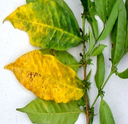 |
Phosphorus (P)
|
|
Reduced growth of plant, restricted root development and leaves dark green. Symptoms appear in older leaves. Irregular yellow areas appear first which may spread to the whole leaf producing mottled appearance. Leaves may turn red or violet under severe conditions and drop easily.
Remedial measure: Foliar application of 0.5% SSP or 1% DAP.
|
Shows up as deficiency of Zn, Fe, or Co. Interferes with N absorption. |
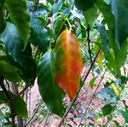 |
Potassium (K)
|
|
Necrosis or scorching of tip and margins in older leaves. Defoliation and dieback under severe deficiency.
Remedial measure: Foliar application of 0.1% MOP.
|
Causes N deficiency in plant and may affect the uptake of other positive ions such as Mg and Ca |
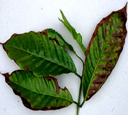 |
Calcium (Ca)
|
|
Inhibition of bud growth; young leaves abnormally green; leaf tips may stick together; curling/cupping of young leaves; stem structure weakened; premature shedding of fruit and buds.
Remedial measure: Liming of soil with good quality calcitic lime
|
Interferes with Mg absorption; high Ca usually causes high pH which then precipitates many of the micronutrient so they become unavailable to the plant. |
 |
Magnesium (Mg)
|
|
In older leaves, large yellow areas (usually surrounded by a light green band) appear in between lateral veins and in either side of the midribs. Yellowing will gradually extend towards leaf margin. Severe deficiency leads to dark, necrotic spot on leaf tip and heavy defoliation.
Remedial measure: Soil application of dolomitic lime or foliar spray of 0.1% Magnesium sulphate
|
Interferes with Ca uptake; small necrotic spots in older leaves; smaller veins in older leaves may turn brown; in advanced stage, young leaves may be spotted. |
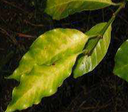 |
Sulphur (S)
|
|
Yellowing of the youngest pair of leaves; chlorosis of mature leaves with newer leaves smaller in size and more chlorotic than the mature leaves; shoot growth is restricted; roots and stems are thinner, hard and woody.
Remedial measure: Soil application of elemental S or fertilizer containing S.
|
Usually excess S is from air pollution |
 |
Zinc (Zn)
|
|
Young leaves are abnormally small and narrow, lanceolate in shape with interveinal chlorosis; leaves bunched at the end of branch (rosette); short internodes; defoliation and dieback in severe deficiency.
Remedial measure: Foliar spray of 0.25% Zinc Sulphate neutralized with spray lime.
|
Appears as Fe deficiency. Interferes with Mg. |
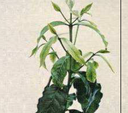 |
Iron (Fe)
|
|
Interveinal chlorosis primarily on young tissue, which may turn light green to yellowish and white when deficiency is severe; all veins including the smallest ones remain green giving a very fine mottling/ reticulation.
Remedial measure: Provide good drainage.
|
Rare except on flooded soils |
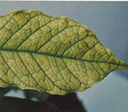 |
Manganese (Mn)
|
|
Interveinal chlorosis in young leaves with checkered effect/coarse mottling; induced by excessively high pH.
Remedial measure: Correcting soil pH
|
Smaller leaves, cupping of leaves along mid-rib; yellowing of the leaf margin; shortening of internodes; defoliation; found under strongly acid conditions |
 |
Copper (Cu)
|
| Young leaves twisted and bent along the midrib; may show slight chlorosis in leaf margins; secondary veins salient (“ribs”), brown symmetric spots. |
Can occur at low pH; shows up as Fe deficiency. Watery and blackish spots in the central part of leaf can also occur. |
 |
Boron (B)
|
|
Young leaves smaller, irregular in shape, leathery texture and without chlorosis; characteristic death of growing tip which turns black; development of lateral branches resulting in fan shaped structure.
Remedial measure: Foliar application of boric acid 100g/200 litre water
|
No reduction in leaf size, mottled chlorosis near the margin, purple hue in the base of mid rib. Tips and margins of leaves exhibit chlorotic/necrotic spots coalescing into a marginal scorch; oldest leaves are affected first; plants are easily damaged by excess application
|
 |
Molybdenum (Mo)
|
|
Very rarely Mo deficiency occurs. Interveinal chlorosis on older leaves; twisted leaves (whiptail); marginal scorching and rolling or cupping of leaves; symptoms similar to N deficiency may develop.
|
Intense yellow or purple color in leaves; rarely observed |
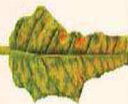
|












